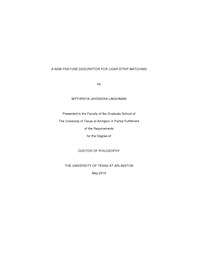
ATTENTION: The works hosted here are being migrated to a new repository that will consolidate resources, improve discoverability, and better show UTA's research impact on the global community. We will update authors as the migration progresses. Please see MavMatrix for more information.
Show simple item record
| dc.contributor.author | Jayendra Lakshman, Mythreya | en_US |
| dc.date.accessioned | 2014-07-14T20:22:10Z | |
| dc.date.available | 2014-07-14T20:22:10Z | |
| dc.date.issued | 2014-07-14 | |
| dc.date.submitted | January 2014 | en_US |
| dc.identifier.other | DISS-12648 | en_US |
| dc.identifier.uri | http://hdl.handle.net/10106/24404 | |
| dc.description.abstract | Light Detection and Ranging (LiDAR) data has been getting a lot of attention these days because of its applicability in various fields - city planning, disaster response & precaution, soil conservation, infrastructure or forestry. Raw LiDAR data is not directly usable in the above-mentioned applications. Therefore, an important aspect of the aerial LIDAR system is to process raw LiDAR data accurately. The processed data is then made available to us in the form of point clouds or digital elevation maps (DEM's) or digital surface maps (DSM's). Each swath of raw data represents a single flight path over a region of interest. Multiple swaths or rectangular strips must be adjusted with respect to each other so that calibration errors and random errors that occur during the acquisition process are corrected.Raw LiDAR data is available in point clouds of overlapping rectangular strips with 10%-30% overlap between the strips. Traditionally, LiDAR point clouds are matched and strip-adjusted (registered with respect to each other) using techniques based on iterative closest point (ICP) method or modifications of the same, which as the name suggests, runs over multiple iterations. The goal of the research presented in this dissertation is to introduce a novel and alternative method for point matching on LiDAR data based on finding point-to-point correspondences on interpolated LiDAR strips. Publically or commercially viable LiDAR data is obtained by rescanning an irregular grid by interpolating the data onto a regular raster grid. This representation is known as 2.5D representation. The novel algorithm presented in this dissertation combines the power of LiDAR elevation data with a keypoint detector and descriptor - all obtained on the 2.5D LiDAR data. The keypoint detector finds interesting keypoints in the LiDAR strip by using standard keypoint detection techniques such as the scale-space blob-detection and corner detection techniques. Elevation statistics obtained from subdivisions of the neighborhood patch surrounding a keypoint are defined as the keypoint descriptor used in the approach presented in this dissertation. The elements of such descriptors are referred to as features. Once all the keypoints and descriptors are obtained for two overlapping patches, correspondences are found using the nearest neighbors of each point in the feature space. These matches can be used to find the homography that is used to transform one swath onto another. Scale Invariant Feature Transformation (SIFT) is a well-known and understood algorithm that uses a similar approach.The novelty of the presented work called the Aerial Range Feature Descriptor (ARFD) is in the adaptive development of unique signatures of each keypoint obtained by examining a patch surrounding that keypoint in the elevation and/or LiDAR intensity data. Such hybrid descriptor development has been made possible only by the availability of pre-registered intensity and elevation data from modern LIDAR platforms. | en_US |
| dc.description.sponsorship | Devarajan, Venkat | en_US |
| dc.language.iso | en | en_US |
| dc.publisher | Electrical Engineering | en_US |
| dc.title | A New Feature Descriptor For LiDARStrip Matching | en_US |
| dc.type | Ph.D. | en_US |
| dc.contributor.committeeChair | Devarajan, Venkat | en_US |
| dc.degree.department | Electrical Engineering | en_US |
| dc.degree.discipline | Electrical Engineering | en_US |
| dc.degree.grantor | University of Texas at Arlington | en_US |
| dc.degree.level | doctoral | en_US |
| dc.degree.name | Ph.D. | en_US |
Files in this item
- Name:
- JayendraLakshman_uta_2502D_126 ...
- Size:
- 1.646Mb
- Format:
- PDF
This item appears in the following Collection(s)
Show simple item record


